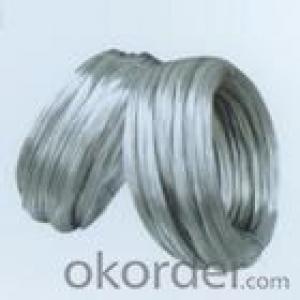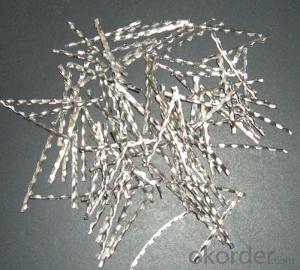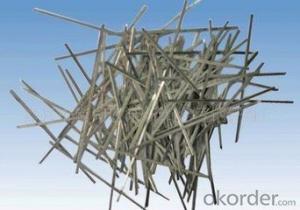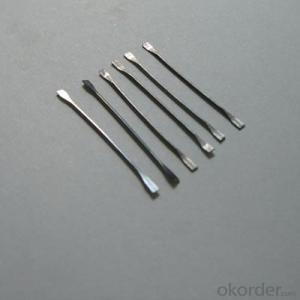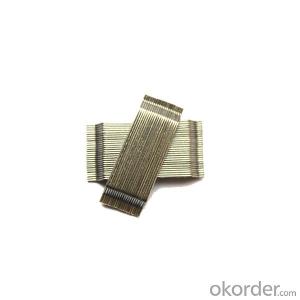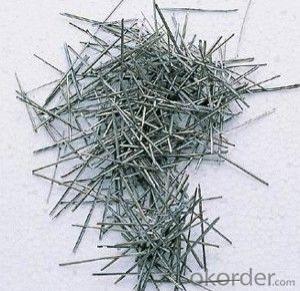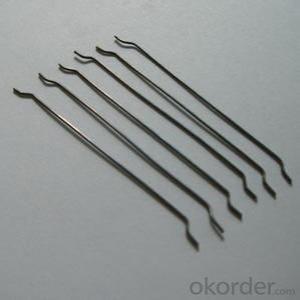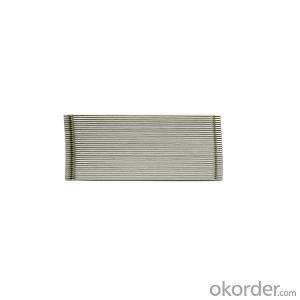Ele GL wire 0.3mm Swg Gi wire from CNBM China
- Loading Port:
- Tianjin
- Payment Terms:
- TT OR LC
- Min Order Qty:
- 1 m.t.
- Supply Capability:
- 10000 m.t./month
OKorder Service Pledge
OKorder Financial Service
You Might Also Like
Quick Details
Place of Origin: Tianjin, China (Mainland)
Surface Treatment: Galvanized
Galvanized Technique: Electro Galvanized
Type: Loop Tie Wire
Function: Baling Wire
Wire Gauge: 0.7-6mm
Business Type: Business Type
Raw material: Low carbon steel, Structural Carbon Steel,Q195
Elongation: 10% -12%
Zinc Coating: 10-270g/sqm
Standard: EN,BS,ASTM,GB
Packaging & Delivery
| Packaging Details: | 25kg or 50kg for each coil,According to customer's requirements |
|---|---|
| Delivery Detail: | 15 |
Product Description
| Business Type | Manufacturer | |||
| Wire Type | Zinc coated wire/Galvanized wire | |||
| Usage & Performance | Baling wire,Binding wire.weaving wire mesh, construction, handicrafts, express way fencing mesh, packaging of products, equipment, medical equipment, brushes, cables, | |||
| Wire Gauge | BWG 4-22 Galvanized Wire Diameter: 0.7-6mm | |||
| Zinc-plated | Hot dipped Galvanized or Electro Galvanized | |||
| Raw material | Low carbon steel, Structural Carbon Steel,Q195 | |||
| Tensile strength | >350 MPa | |||
| Elongation | 10% -12% | |||
| Zinc Coating: | 10-270g/sqm Electro Galv. Wire-Zinc coating: 10g-25g/m2, Hot Dipped Galv. Wire-Zinc coating: 40g-70g/m2/200g-270g/m2 | |||
| Standard | EN,BS,ASTM,GB | |||
| Certification | ISO9001:2000, CE, | |||
| Packing | Standard Coil Packing Unit | Weight | 25kg or 50kg for each coil | |
| Inner Dia. (φ/mm) | 200/400 | |||
| Inner Wrappage | Plastic film | |||
| Outside Wrappage | Woven bag or Hessian cloth | |||
| Export Bulk Packing | Export Packing | 500kg or 1,000kg for each coil | ||
| Customized Packing | 5kg to 500kg for each coil | |||
| Bulk Packing | 500kg/ Bulk coil | |||
| Inner and Outside Dia. (φ/mm) | According to customer's requirements | |||
| Wrappage | According to customer's requirements | |||
| Loading Quantity | 20’GP | 20-25 Tonne/Tonnes | ||
| 40’GP | 25-27 Tonne/Tonnes | |||
| 40’HQ | 25-27 Tonne/Tonnes | |||
| MOQ | 1 kg for trial order | |||
| Supply Ability | 10,000 Tonne/Tonnes per Year | |||
| Payment Terms | T/T or L/C at sight | |||
| Delivery Time | Within 15 days after receiving deposit or original L/C at sight | |||
| Remark | Customized order and specific requirements is available. | |||
- Q:Can melt extract stainless steel fiber be used in concrete pipes and culverts?
- Yes, melt extract stainless steel fiber can be used in concrete pipes and culverts. The addition of stainless steel fiber enhances the strength, durability, and crack resistance of the concrete, making it better equipped to withstand the demanding conditions and stresses typically encountered in pipes and culverts.
- Q:Does melt extract stainless steel fiber improve the crack control of concrete elements?
- Yes, melt extract stainless steel fiber can indeed improve the crack control of concrete elements. When added to concrete mixtures, these fibers help to enhance the overall tensile strength and ductility of the concrete. This, in turn, reduces the likelihood of cracking and improves the crack control of the concrete elements. Melt extract stainless steel fibers are known for their high tensile strength and excellent bonding properties with concrete. These fibers act as reinforcement within the concrete matrix, providing additional support and preventing the propagation of cracks. They effectively distribute stress throughout the concrete, mitigating the risk of crack formation and improving the overall durability and longevity of the concrete elements. Furthermore, melt extract stainless steel fibers also help to control shrinkage and thermal cracking in concrete. As the concrete cures and undergoes temperature changes, these fibers act as a reinforcement grid, limiting the development of cracks caused by thermal expansion and contraction. This is particularly beneficial in environments with extreme temperature variations. Overall, the addition of melt extract stainless steel fiber to concrete mixtures significantly enhances the crack control of concrete elements. It improves the tensile strength, ductility, and overall durability of the concrete, reducing the occurrence and propagation of cracks. This makes it a valuable material for various applications, including structural elements, pavements, and precast concrete products.
- Q:How does melt extract stainless steel fiber enhance the crack resistance of concrete?
- Melt extract stainless steel fiber enhances the crack resistance of concrete through several mechanisms. Firstly, the addition of stainless steel fibers to the concrete mix increases its tensile strength. This means that the concrete is better able to resist the forces that cause cracking, such as shrinkage, temperature changes, and external loads. The fibers help to distribute these forces more evenly throughout the concrete, reducing the likelihood of cracks forming. Secondly, stainless steel fibers act as reinforcement within the concrete matrix. When cracks do occur, the fibers help to hold the concrete together and prevent the cracks from propagating further. This improves the overall durability and longevity of the concrete structure. Furthermore, melt extract stainless steel fibers also enhance the impact resistance of concrete. The fibers absorb and distribute the energy from impacts, reducing the likelihood of cracks forming or propagating due to sudden loading. Additionally, stainless steel fibers can also improve the resistance of concrete to chemical attack. They provide a physical barrier that inhibits the penetration of aggressive chemicals, such as chlorides or sulfates, into the concrete. This helps to prevent the deterioration of the concrete and reduces the risk of cracks forming due to chemical exposure. Overall, melt extract stainless steel fiber enhances the crack resistance of concrete by improving its tensile strength, reinforcing the concrete matrix, increasing its impact resistance, and providing a barrier against chemical attack. These combined effects result in a more durable and crack-resistant concrete structure.
- Q:What is the effect of melt extract stainless steel fiber on the toughness of concrete?
- Adding melt extract stainless steel fiber to concrete can result in a positive impact on its toughness. Typically, stainless steel fibers are utilized as reinforcement in concrete to enhance its mechanical properties, specifically its toughness. When incorporated into concrete, these fibers function as tiny reinforcements that aid in the distribution of stress and the prevention of cracking. Through this reinforcement, the concrete's overall toughness is improved, rendering it more resistant to external forces such as impacts, vibrations, and other types of stress. The effectiveness of melt extract stainless steel fibers in enhancing toughness lies in their remarkable strength and durability. Being resistant to corrosion, these fibers ensure their long-term effectiveness in concrete structures. Moreover, their small size and high aspect ratio contribute to a stronger bond between the fibers and the surrounding matrix, further enhancing the concrete's overall toughness. In summary, the addition of melt extract stainless steel fiber to concrete elevates its toughness, resulting in improved resilience and durability. This proves particularly advantageous in scenarios where concrete is subjected to heavy loads, dynamic forces, or harsh environmental conditions.
- Q:How does melt extract stainless steel fiber affect the shear strength of concrete?
- Melt extract stainless steel fiber improves the shear strength of concrete by enhancing its crack resistance and preventing crack propagation. The fibers act as reinforcement within the concrete matrix, increasing its structural integrity and ability to withstand shear forces.
- Q:Can melt extract stainless steel fiber be used in precast bridge elements?
- Yes, melt extract stainless steel fiber can be used in precast bridge elements. Melt extract stainless steel fibers are known for their high tensile strength, corrosion resistance, and durability, making them suitable for use in various construction applications, including precast bridge elements. These fibers can enhance the mechanical properties of concrete, such as its flexural strength and crack resistance, thereby improving the overall performance and lifespan of the bridge elements. Additionally, the use of stainless steel fibers can also reduce the need for traditional reinforcement, leading to cost savings and faster construction. However, it is important to ensure that the fiber dosage and distribution are properly controlled during the precast fabrication process to achieve optimal performance and structural integrity.
- Q:How does melt extract stainless steel fiber enhance the impact resistance of concrete?
- Melt extract stainless steel fiber enhances the impact resistance of concrete through several mechanisms. Firstly, the addition of stainless steel fibers in concrete increases its tensile strength, resulting in improved resistance to cracking and spalling upon impact. These fibers act as reinforcement, distributing the load more evenly throughout the concrete matrix, thus reducing the concentration of stress at any particular point. Furthermore, the high aspect ratio of stainless steel fibers allows them to bridge across cracks that may occur under impact, effectively inhibiting their propagation. This bridging effect not only enhances the overall structural integrity of the concrete but also prevents the development of larger cracks that could compromise its impact resistance. Additionally, the unique properties of stainless steel, such as its high strength and corrosion resistance, make it an ideal material for enhancing the impact resistance of concrete. Stainless steel fibers are highly durable and can withstand the harsh conditions often encountered in concrete structures, including exposure to chemicals, moisture, and temperature variations. Moreover, the random distribution of stainless steel fibers within the concrete mix creates a three-dimensional reinforcement network, which helps to absorb and dissipate energy upon impact. This energy absorption capability reduces the force transmitted through the concrete, minimizing the risk of damage or failure under impact loadings. Overall, the incorporation of melt extract stainless steel fiber in concrete significantly enhances its impact resistance by improving its tensile strength, inhibiting crack propagation, providing durability, and absorbing energy. This reinforcement technique is particularly beneficial in applications where concrete structures are subjected to frequent impact or dynamic loads, such as industrial floors, pavements, bridge decks, and blast-resistant structures.
- Q:What is the cost-effectiveness of using melt extract stainless steel fiber?
- The cost-effectiveness of using melt extract stainless steel fiber can vary depending on factors such as the specific application, project requirements, and the overall cost of the fiber itself. However, generally speaking, melt extract stainless steel fiber is considered to be cost-effective due to its durability, high tensile strength, and resistance to corrosion. These properties can result in reduced maintenance and repair costs over time, making it a cost-effective choice for applications that require reinforcement or enhanced durability.
- Q:Is melt extract stainless steel fiber compatible with different types of shotcrete accelerators?
- Different types of shotcrete accelerators can be used with melt extract stainless steel fiber, as they are compatible. Shotcrete accelerators are employed to quicken the setting and hardening processes of shotcrete or concrete. To enhance the mechanical properties and durability of the final product, melt extract stainless steel fibers are frequently incorporated into shotcrete mixes. These fibers, made from stainless steel, possess exceptional corrosion resistance, allowing them to be compatible with various shotcrete accelerators. The inclusion of melt extract stainless steel fibers can bolster the bond strength, crack resistance, and impact resistance of shotcrete, regardless of the accelerator type. Thus, it is safe to assert that melt extract stainless steel fiber is compatible with different types of shotcrete accelerators.
- Q:What is the effect of melt extract stainless steel fiber on the impact strength of concrete?
- The effect of melt extract stainless steel fiber on the impact strength of concrete is significant. When stainless steel fibers are added to concrete, they enhance its toughness and resistance to impact forces. The fibers act as reinforcement within the concrete matrix, effectively distributing the stress and preventing crack propagation. The unique properties of stainless steel fibers, such as their high tensile strength, ductility, and corrosion resistance, make them an excellent choice for improving the impact strength of concrete. These fibers can absorb and dissipate energy when subjected to impact loads, reducing the risk of brittle failure. The addition of melt extract stainless steel fibers in concrete can greatly enhance its ability to withstand impacts from heavy loads or dynamic forces. This is particularly beneficial in applications where the concrete structure is exposed to vehicular traffic, heavy machinery, or other sources of impact. Moreover, the use of stainless steel fibers in concrete can also improve its overall durability and lifespan. By reducing the formation of cracks and preventing their propagation, the fibers enhance the concrete's resistance to environmental factors, such as freeze-thaw cycles, chemical attacks, and abrasion. In summary, incorporating melt extract stainless steel fibers into concrete significantly improves its impact strength. This reinforcement leads to a more durable and resilient concrete structure, capable of withstanding heavy impacts and ensuring the long-term integrity of the construction.
1. Manufacturer Overview |
|
|---|---|
| Location | |
| Year Established | |
| Annual Output Value | |
| Main Markets | |
| Company Certifications | |
2. Manufacturer Certificates |
|
|---|---|
| a) Certification Name | |
| Range | |
| Reference | |
| Validity Period | |
3. Manufacturer Capability |
|
|---|---|
| a)Trade Capacity | |
| Nearest Port | |
| Export Percentage | |
| No.of Employees in Trade Department | |
| Language Spoken: | |
| b)Factory Information | |
| Factory Size: | |
| No. of Production Lines | |
| Contract Manufacturing | |
| Product Price Range | |
Send your message to us
Ele GL wire 0.3mm Swg Gi wire from CNBM China
- Loading Port:
- Tianjin
- Payment Terms:
- TT OR LC
- Min Order Qty:
- 1 m.t.
- Supply Capability:
- 10000 m.t./month
OKorder Service Pledge
OKorder Financial Service
Similar products
New products
Hot products
Related keywords
